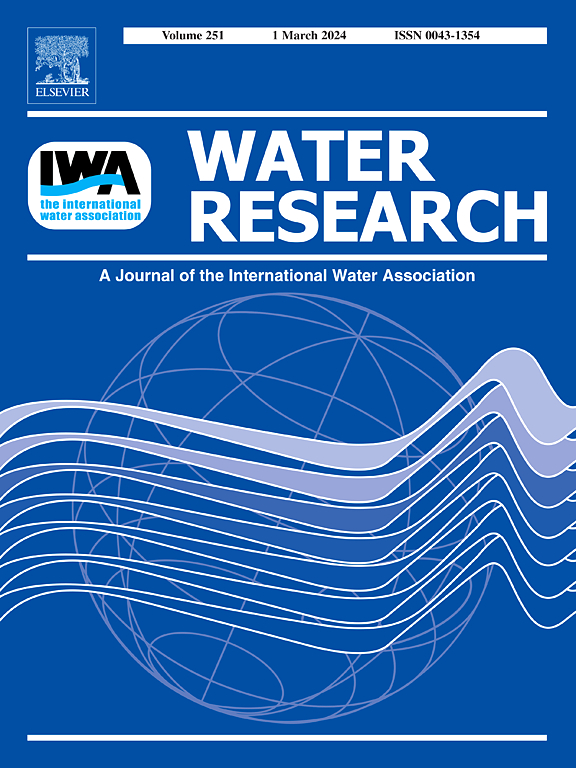Removal of organic micropollutants under dry and wet weather conditions in a full-scale aerobic granular sludge plant
IF 12.4
1区 环境科学与生态学
Q1 ENGINEERING, ENVIRONMENTAL
引用次数: 0
Abstract
Aerobic granular sludge (AGS) process is an effective wastewater treatment technology for nutrient and organic matter removal and is being widely applied worldwide. To date, its performance in removing organic micropollutants (OMPs), particularly under wet weather conditions when operation differs, remains poorly understood. This study evaluated the occurrence and removal of OMPs, including 19 pharmaceuticals and 2 industrial compounds, in a full-scale AGS plant during one year under both dry and wet weather conditions. Under dry weather conditions, influent concentrations of 5 pharmaceuticals and 1 industrial compound exceeded 1 μg L−1. Rainfall resulted in diluted OMP influent concentrations, but also caused a significant increase in the influent load of 6 OMPs with positively charged functional groups, likely due to mobilization of sewage sediments that had adsorbed these OMPs. Under dry weather conditions, average removal efficiencies of 14 compounds were greater than 20 %, with 6 of these compounds detected in the sludge phase, and thus likely removed through sorption. Under wet weather conditions, OMP removal efficiencies decreased by 8 % to 38 %. Shortened aeration reaction time significantly reduced (p-value<0.05; R2>0.5) the removal of 8 potentially biodegradable compounds, while the impact on sorption-driven removal was limited for 6 compounds. Effluent OMP load increased under wet weather conditions, mainly due to reduced removal efficiency, rather than the discharge of OMPs adsorbed onto suspended solids. Under dry weather conditions, the AGS plant exhibited comparable or slightly higher OMP removal efficiencyies than activated sludge plants; however, differences in performance under wet weather conditions remain unclear due to limited data on activated sludge systems. Overall, this study is the first to assess OMP removal in a full-scale AGS plant under wet weather, showing the impact of increased flow on the sorption and biotransformation of OMPs.


大型好氧颗粒污泥厂干湿天气条件下有机微污染物的去除
好氧颗粒污泥法(AGS)是一种去除营养物和有机物的有效废水处理技术,在世界范围内得到了广泛的应用。迄今为止,它在去除有机微污染物(omp)方面的性能,特别是在不同操作条件下的潮湿天气条件下,仍然知之甚少。本研究评估了在干燥和潮湿的气候条件下,在一个完整的AGS工厂一年内omp的发生和去除,包括19种药物和2种工业化合物。在干燥条件下,5种药物和1种工业化合物的浓度超过1 μg L−1。降雨导致进水的OMP浓度被稀释,但也导致6种带正电官能团的OMP的进水负荷显著增加,这可能是由于吸附了这些OMP的污水沉积物的动员。在干燥天气条件下,14种化合物的平均去除率大于20%,其中6种化合物在污泥阶段被检测到,因此可能通过吸附被去除。在潮湿的天气条件下,OMP的去除效率下降了8%至38%。缩短曝气反应时间显著降低(p值<;0.05;R2>0.5)对8种潜在可生物降解化合物的去除,而对6种化合物的吸附驱动去除影响有限。在潮湿天气条件下,出水OMP负荷增加,主要是由于去除效率降低,而不是由于吸附在悬浮固体上的OMP排放。在干燥气候条件下,AGS装置的OMP去除率与活性污泥装置相当或略高;然而,由于活性污泥系统的数据有限,在潮湿天气条件下的性能差异仍不清楚。总的来说,这项研究首次评估了在潮湿天气下,全尺寸AGS工厂对OMP的去除效果,显示了流量增加对OMP吸附和生物转化的影响。
本文章由计算机程序翻译,如有差异,请以英文原文为准。
求助全文
约1分钟内获得全文
求助全文
来源期刊

Water Research
环境科学-工程:环境
CiteScore
20.80
自引率
9.40%
发文量
1307
审稿时长
38 days
期刊介绍:
Water Research, along with its open access companion journal Water Research X, serves as a platform for publishing original research papers covering various aspects of the science and technology related to the anthropogenic water cycle, water quality, and its management worldwide. The audience targeted by the journal comprises biologists, chemical engineers, chemists, civil engineers, environmental engineers, limnologists, and microbiologists. The scope of the journal include:
•Treatment processes for water and wastewaters (municipal, agricultural, industrial, and on-site treatment), including resource recovery and residuals management;
•Urban hydrology including sewer systems, stormwater management, and green infrastructure;
•Drinking water treatment and distribution;
•Potable and non-potable water reuse;
•Sanitation, public health, and risk assessment;
•Anaerobic digestion, solid and hazardous waste management, including source characterization and the effects and control of leachates and gaseous emissions;
•Contaminants (chemical, microbial, anthropogenic particles such as nanoparticles or microplastics) and related water quality sensing, monitoring, fate, and assessment;
•Anthropogenic impacts on inland, tidal, coastal and urban waters, focusing on surface and ground waters, and point and non-point sources of pollution;
•Environmental restoration, linked to surface water, groundwater and groundwater remediation;
•Analysis of the interfaces between sediments and water, and between water and atmosphere, focusing specifically on anthropogenic impacts;
•Mathematical modelling, systems analysis, machine learning, and beneficial use of big data related to the anthropogenic water cycle;
•Socio-economic, policy, and regulations studies.
 求助内容:
求助内容: 应助结果提醒方式:
应助结果提醒方式:


